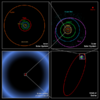JuaKali
JF-Expert Member
- Nov 14, 2007
- 776
- 118
Hizi nyota mbili yaani Venus na Jupiter hua zinaonekana kua karibu na mwezi kwa sisi hapa duniani lakini ukweli ni kwamba zimepishana kwa umbali mkubwa mno. Kutoka hapa duniani, mwezi uko maili 252,000, Venus iko maili 94 milioni na Jupiter maili 540 milioni! Nyota hizi huwa zinakaribiana mara kwa mara isipokuwa sisi huku duniani hatuoni kwa sababu wakati mwingine zinakuwa karibu na jua na inakuwa vigumu sisi huku duniani kuona. Inatabiriwa kuwa katika mkesha wa mwaka mpya tukio kama hili la jana litatokea tena lakini kwa nyota mbili tu yaani Venus na mwezi.
Mkuu huoni umbali ulivyo tofauti kati ya hizi sayari mbili? na mzunguko wake kulizunguka jua unawiana na umbali uliopo btw them. Ninavyofikiria ni kwamba sayari nyingine zinakaribia mara kwa mara (eg Jupiter na dunia, or Jupiter na mars) lakini siyo Venus na Jupiter kukaribiana mara kwa mara (diameter diff). Unless nimeelewa tofauti maelezo yako, utanisamehe!
